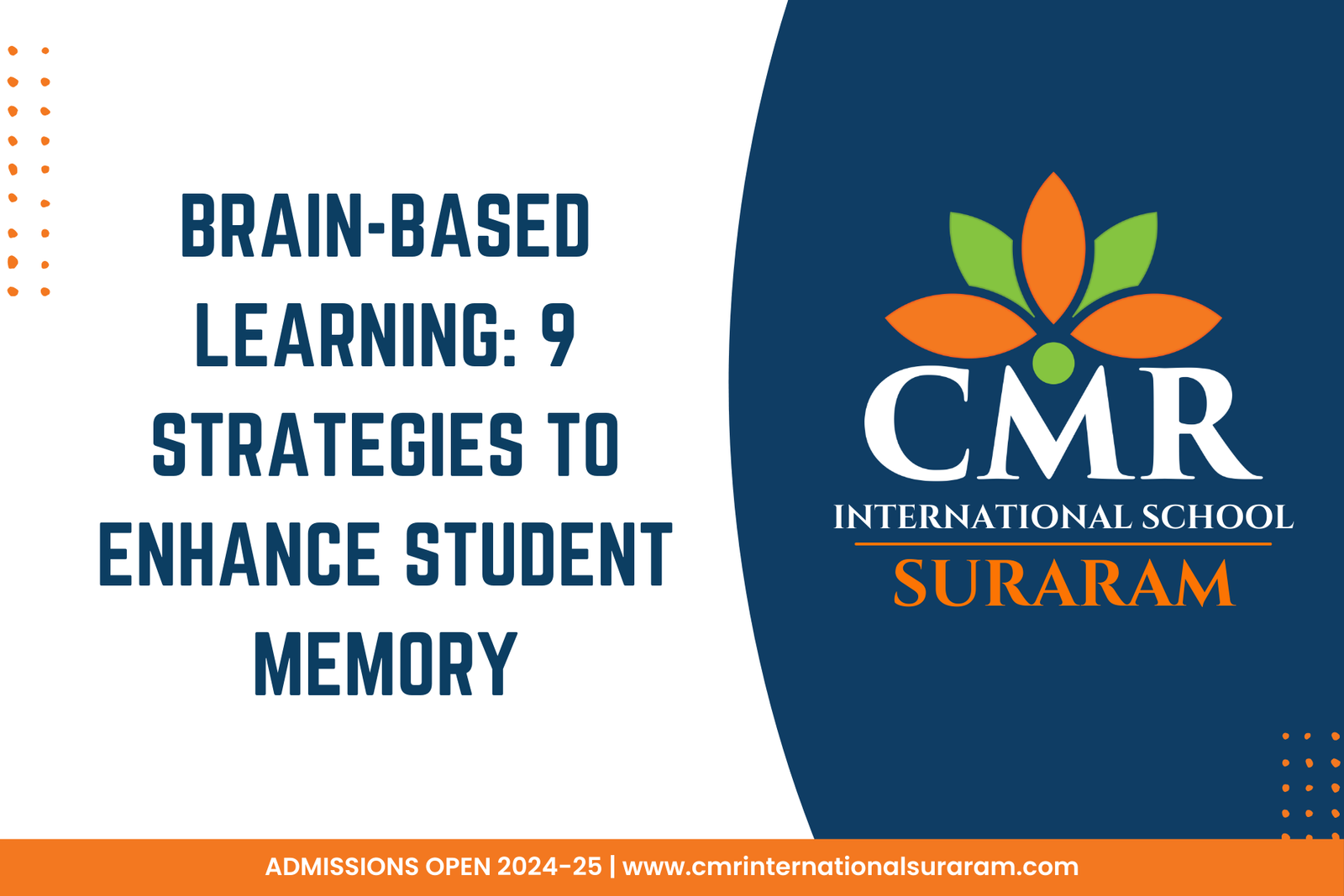Welcome to our guide on brain-based learning strategies, brought to you by CMR International School, Suraram. In this article, we’ll explore effective methods to boost student memory and learning. Think of this as your toolkit for enhancing academic performance and making studying a lot more engaging. Let’s dive into these powerful techniques!
Introduction
Imagine your brain as a sponge—its ability to absorb and retain information can be greatly improved with the right techniques. Brain-based learning focuses on how we can harness our understanding of the brain’s functions to enhance learning and memory. At CMR International School, Suraram, we emphasize using these cutting-edge strategies to help our students excel. In this guide, we’ll cover nine effective strategies to boost memory and make learning a more dynamic experience.
Understanding Brain-Based Learning
Brain-based learning is about tailoring teaching methods to align with how the brain naturally processes and stores information. By understanding the brain’s mechanisms, we can apply strategies that make learning more effective and enjoyable.
Key Points:
- Cognitive Processes: Knowledge of how memory and learning work helps in applying the right strategies.
- Effective Teaching: Techniques based on brain science can enhance engagement and retention.
1. Active Learning
Active learning involves engaging with the material through activities rather than passively listening or reading. It’s like turning learning into a game where you’re actively participating rather than just observing.
Key Points:
- Interactive Sessions: Use discussions, group work, and hands-on activities to reinforce learning.
- Practical Application: Applying concepts in real-life scenarios helps solidify understanding.
Example: Instead of just reading about historical events, students might role-play historical figures to better grasp the material.
2. Visual Learning Techniques
Visual learning techniques utilize imagery, diagrams, and charts to help students understand and remember information. Imagine trying to remember a phone number—visualizing the numbers on a keypad can make them easier to recall.
Key Points:
- Use of Diagrams: Visual aids like mind maps and flowcharts can simplify complex information.
- Incorporating Images: Illustrations and videos can enhance comprehension and retention.
Example: A biology teacher might use diagrams of the human body to teach about organs and their functions.
3. Multi-Sensory Learning
Multi-sensory learning engages more than one sense at a time, which can enhance memory by creating more connections in the brain. It’s like using a recipe that combines multiple ingredients to create a richer flavor.
Key Points:
- Engage Multiple Senses: Combine visual, auditory, and tactile inputs for a richer learning experience.
- Hands-On Activities: Activities like building models or conducting experiments can reinforce learning.
Example: Learning about physical science might involve experiments where students see, touch, and record results.
4. Retrieval Practice
Retrieval practice involves actively recalling information rather than passively reviewing it. This technique helps strengthen memory by challenging the brain to retrieve and use learned information.
Key Points:
- Regular Quizzes: Frequent quizzes or self-testing can improve long-term retention.
- Practice Retrieval: Encourage students to recall information without referring to notes.
Example: After a lesson, students could have a brief quiz or write a summary from memory to reinforce the material.
5. Spaced Repetition
Spaced repetition involves revisiting information at increasing intervals. Instead of cramming all at once, this technique spreads learning over time, which helps consolidate memory.
Key Points:
- Interval Review: Plan study sessions to review material periodically.
- Long-Term Retention: This technique helps transfer information from short-term to long-term memory.
Example: Reviewing vocabulary words once a week over several months helps reinforce learning better than a single review session.
6. Interleaved Practice
Interleaved practice mixes different topics or skills in a single study session. This method helps improve problem-solving skills by encouraging students to apply different strategies to various types of problems.
Key Points:
- Mix Topics: Instead of studying one topic at a time, mix different subjects or skills.
- Application Variety: Helps in applying knowledge flexibly across different contexts.
Example: A math session might include problems on algebra, geometry, and statistics rather than focusing on one area.
7. Teaching Others
Teaching others is a powerful way to reinforce your own learning. When students teach or explain concepts to others, they deepen their understanding and retention.
Key Points:
- Peer Teaching: Encourage students to explain concepts to classmates or family members.
- Active Engagement: Teaching forces students to organize their thoughts and clarify their understanding.
Example: After learning a new concept, a student might explain it to a friend or family member to solidify their own grasp of the topic.
8. Mindfulness and Stress Reduction
Stress and anxiety can hinder memory and learning. Mindfulness practices, such as meditation and deep breathing, can help reduce stress and improve cognitive function.
Key Points:
- Stress Management: Implement mindfulness techniques to manage stress and improve focus.
- Cognitive Benefits: Mindfulness can enhance concentration and memory.
Example: Incorporating short mindfulness exercises into the school day can help students manage stress and improve overall well-being.
9. Healthy Lifestyle Choices
A healthy lifestyle significantly impacts brain function and memory. Proper nutrition, regular exercise, and adequate sleep are essential for optimal cognitive performance.
Key Points:
- Balanced Diet: Foods rich in omega-3 fatty acids, antioxidants, and other nutrients support brain health.
- Regular Exercise: Physical activity boosts cognitive function and overall mental health.
- Adequate Sleep: Quality sleep is crucial for memory consolidation and cognitive performance.
Example: Encouraging students to eat a balanced diet, exercise regularly, and get enough sleep can improve their overall academic performance.
How to Implement These Strategies
Implementing these strategies involves integrating them into daily routines and educational practices. Schools, teachers, and parents can work together to incorporate these techniques into learning activities.
Key Points:
- Teacher Training: Educators can be trained to use brain-based learning strategies effectively.
- Parental Involvement: Parents can support these techniques at home to reinforce learning.
- Student Engagement: Actively involve students in applying these strategies to make learning more effective.
Example: A school might organize workshops for teachers on brain-based learning and provide resources for parents to support these methods at home.
The Role of Schools in Supporting Memory Techniques
Schools play a crucial role in applying brain-based learning techniques. By creating an environment that supports these strategies, schools can enhance student learning and memory.
Key Points:
- Curriculum Design: Integrate brain-based learning strategies into the curriculum.
- Supportive Environment: Foster a learning environment that encourages active engagement and healthy habits.
Example: At CMR International School, Suraram, we focus on implementing brain-based learning techniques to support our students’ academic and personal growth.
FAQs
1. What is brain-based learning?
Brain-based learning focuses on teaching methods that align with how the brain naturally processes and stores information, enhancing learning and memory.
2. How does active learning improve memory?
Active learning involves engaging with material through activities, which helps reinforce and retain information more effectively than passive learning.
3. What are visual learning techniques?
Visual learning techniques use imagery, diagrams, and charts to help students understand and remember information better.
4. How does multi-sensory learning enhance memory?
Multi-sensory learning engages multiple senses simultaneously, creating more connections in the brain and improving memory retention.
5. What is retrieval practice and how does it work?
Retrieval practice involves actively recalling information to strengthen memory and improve long-term retention.
Conclusion
Brain-based learning strategies can profoundly impact how students retain and apply information. By utilizing techniques such as active learning, retrieval practice, and healthy lifestyle choices, students can enhance their memory and academic performance. At CMR International School, Suraram, we are committed to using these methods to help our students achieve their full potential.
Admissions are in progress for 2024-25
Contact details: CMR International School, Suraram
+91 79930 17777
+91 79935 67777



